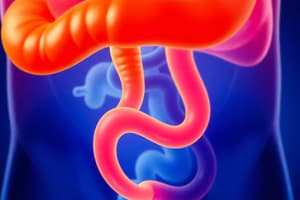Podcast
Questions and Answers
What is the underlying mechanism that leads to steatorrhea in conditions of bile salt deficiency?
What is the underlying mechanism that leads to steatorrhea in conditions of bile salt deficiency?
Inadequate bile salts lead to impaired fat emulsification and absorption, resulting in increased excretion of fat in the feces.
How does the D-xylose absorption test differentiate between small intestinal mucosal disease and hepatobiliary/pancreatic disease?
How does the D-xylose absorption test differentiate between small intestinal mucosal disease and hepatobiliary/pancreatic disease?
In small intestinal mucosal disease, D-xylose absorption is decreased, leading to lower urinary excretion. In hepatobiliary/pancreatic disease, D-xylose absorption remains normal, resulting in normal urinary excretion.
What is the significance of detecting PAS-positive macrophages in the lamina propria during duodenal endoscopy, and which disease is it associated with?
What is the significance of detecting PAS-positive macrophages in the lamina propria during duodenal endoscopy, and which disease is it associated with?
PAS-positive macrophages containing nonacid-fast, Gram-positive bacilli in the lamina propria are a characteristic finding in Whipple's disease.
Describe the typical signs and symptoms that suggest a patient has malabsorption of fat-soluble vitamins.
Describe the typical signs and symptoms that suggest a patient has malabsorption of fat-soluble vitamins.
What is the primary defect in abetalipoproteinemia, and how does it result in malabsorption?
What is the primary defect in abetalipoproteinemia, and how does it result in malabsorption?
What is the diagnostic test for SIBO, and what result indicates the condition?
What is the diagnostic test for SIBO, and what result indicates the condition?
How do the clinical manifestations of coeliac disease typically differ in children versus adults?
How do the clinical manifestations of coeliac disease typically differ in children versus adults?
What is the role of HLA-DQ2 and HLA-DQ8 in the diagnosis of coeliac disease, and how does the absence of these genes impact the diagnosis?
What is the role of HLA-DQ2 and HLA-DQ8 in the diagnosis of coeliac disease, and how does the absence of these genes impact the diagnosis?
Briefly explain the utility of the Modified Marsh classification in the context of coeliac disease.
Briefly explain the utility of the Modified Marsh classification in the context of coeliac disease.
What dietary modifications are essential for the management of coeliac disease, and why is strict adherence important?
What dietary modifications are essential for the management of coeliac disease, and why is strict adherence important?
How does tropical sprue typically affect individuals who reside outside the equatorial region, and what factor is key when diagnosing?
How does tropical sprue typically affect individuals who reside outside the equatorial region, and what factor is key when diagnosing?
State the rationale for using antibiotics and folate in the treatment of tropical sprue.
State the rationale for using antibiotics and folate in the treatment of tropical sprue.
Briefly describe the etiology of lactose intolerance, highlighting the difference that distinguishes primary from secondary intolerance.
Briefly describe the etiology of lactose intolerance, highlighting the difference that distinguishes primary from secondary intolerance.
What is the underlying cause of 'string sign' in Crohn's disease, as observed in imaging studies?
What is the underlying cause of 'string sign' in Crohn's disease, as observed in imaging studies?
Aside from dietary changes, what are some other interventional strategies can be employed in the management of lactose intolerance?
Aside from dietary changes, what are some other interventional strategies can be employed in the management of lactose intolerance?
How would you screen for fat malabsorption and what quantitative lab value is suggestive of abnormal fat absorption?
How would you screen for fat malabsorption and what quantitative lab value is suggestive of abnormal fat absorption?
What are some of the risk factors for developing SIBO?
What are some of the risk factors for developing SIBO?
How do the results for D-xylose absorption test differ in small intestinal mucosal disease to that of hepatobiliary and pancreatic disease?
How do the results for D-xylose absorption test differ in small intestinal mucosal disease to that of hepatobiliary and pancreatic disease?
What are the main components of the Whipple's Disease pneumonic?
What are the main components of the Whipple's Disease pneumonic?
What is the most sensitive and specific serological test for Coeliac disease?
What is the most sensitive and specific serological test for Coeliac disease?
Explain why a patient with significant small intestinal disease might have a normal D-xylose test result, even with absorptive dysfunction.
Explain why a patient with significant small intestinal disease might have a normal D-xylose test result, even with absorptive dysfunction.
A patient presents with suspected malabsorption, and initial fecal fat testing is inconclusive. Describe a more sensitive test that is used to assess fat malabsorption.
A patient presents with suspected malabsorption, and initial fecal fat testing is inconclusive. Describe a more sensitive test that is used to assess fat malabsorption.
How does abetalipoproteinemia lead to fat malabsorption, and why does this result in the accumulation of triglycerides in the liver and intestine?
How does abetalipoproteinemia lead to fat malabsorption, and why does this result in the accumulation of triglycerides in the liver and intestine?
Explain the role of immunohistochemical staining in the diagnosis of Whipple's disease, and why is it more specific than PCR of saliva or gastric fluid?
Explain the role of immunohistochemical staining in the diagnosis of Whipple's disease, and why is it more specific than PCR of saliva or gastric fluid?
Outline the rationale for using both antibiotics and hydroxychloroquine in the treatment of Whipple's disease.
Outline the rationale for using both antibiotics and hydroxychloroquine in the treatment of Whipple's disease.
Explain why some physicians advocate for an empiric trial of antibiotics as the best diagnostic test for SIBO, even in the absence of definitive diagnostic evidence.
Explain why some physicians advocate for an empiric trial of antibiotics as the best diagnostic test for SIBO, even in the absence of definitive diagnostic evidence.
Detail why the hydrogen breath test might yield false negative results, impacting SIBO diagnostic accuracy.
Detail why the hydrogen breath test might yield false negative results, impacting SIBO diagnostic accuracy.
Describe why secondary lactose intolerance is often transient, and what underlying mechanisms contribute to its resolution.
Describe why secondary lactose intolerance is often transient, and what underlying mechanisms contribute to its resolution.
Explain how variations in dietary gluten intake can affect the reliability of diarrhea as a diagnostic symptom in Coeliac disease.
Explain how variations in dietary gluten intake can affect the reliability of diarrhea as a diagnostic symptom in Coeliac disease.
Outline the logic behind intentionally challenging a patient with lactose after a period of avoidance, referencing specific diagnostic benefits.
Outline the logic behind intentionally challenging a patient with lactose after a period of avoidance, referencing specific diagnostic benefits.
A patient presents with suspected Coeliac disease, but serological tests are negative. Explain a potential cause and how it would be addressed.
A patient presents with suspected Coeliac disease, but serological tests are negative. Explain a potential cause and how it would be addressed.
A patient with Coeliac's disease has persistent symptoms and villous atrophy despite strict adherence to a gluten-free diet for over a year. How is this condition defined and managed?
A patient with Coeliac's disease has persistent symptoms and villous atrophy despite strict adherence to a gluten-free diet for over a year. How is this condition defined and managed?
Describe the role of genetic testing (HLA-DQ2 and HLA-DQ8) in ruling out Coeliac disease, and outline its limitations.
Describe the role of genetic testing (HLA-DQ2 and HLA-DQ8) in ruling out Coeliac disease, and outline its limitations.
Outline one reason for performing an abdominal CT scan in a patient diagnosed with Coeliac disease using duodenal biopsy.
Outline one reason for performing an abdominal CT scan in a patient diagnosed with Coeliac disease using duodenal biopsy.
How might poorly controlled diabetes mellitus indirectly contribute to steatorrhea, even in the absence of direct pancreatic or intestinal pathology?
How might poorly controlled diabetes mellitus indirectly contribute to steatorrhea, even in the absence of direct pancreatic or intestinal pathology?
Detail the connection between chronic ulcerative colitis and the development of sclerosing cholangitis and how might the latter condition affect malabsorption?
Detail the connection between chronic ulcerative colitis and the development of sclerosing cholangitis and how might the latter condition affect malabsorption?
Explain how intestinal lymphangiectasia can lead to malabsorption & resultant nutritional deficiencies.
Explain how intestinal lymphangiectasia can lead to malabsorption & resultant nutritional deficiencies.
Explain a situation where empirical avoidance of gluten in a patient could have a negative effect on the accuracy of subsequent diagnostic testing for celiac disease.
Explain a situation where empirical avoidance of gluten in a patient could have a negative effect on the accuracy of subsequent diagnostic testing for celiac disease.
If diagnosing Whipple's disease, but an intestinal biopsy is not possible, suggest an alternative biopsy site to use for diagnosis.
If diagnosing Whipple's disease, but an intestinal biopsy is not possible, suggest an alternative biopsy site to use for diagnosis.
What is the most reliable screening test for malabsorption and why?
What is the most reliable screening test for malabsorption and why?
Flashcards
Malabsorption Definition
Malabsorption Definition
Interruption of normal digestion, absorption, and transport of nutrients and minerals resulting in malnutrition, diarrhea, steatorrhea, and weight loss.
Steatorrhea
Steatorrhea
Increased number of foul-smelling stools with an oily character.
Quantitative fecal fat analysis
Quantitative fecal fat analysis
Measurement of fecal fat content for 48 to 72 hours while the patient is on a 100 g per 24-hour fat diet.
D-xylose absorption test
D-xylose absorption test
Signup and view all the flashcards
Abetalipoproteinemia
Abetalipoproteinemia
Signup and view all the flashcards
Whipple's Disease Cause
Whipple's Disease Cause
Signup and view all the flashcards
Small Intestinal Bacterial Overgrowth (SIBO)
Small Intestinal Bacterial Overgrowth (SIBO)
Signup and view all the flashcards
SIBO gold standard diagnosis
SIBO gold standard diagnosis
Signup and view all the flashcards
Lactose intolerance
Lactose intolerance
Signup and view all the flashcards
Celiac Disease Definition
Celiac Disease Definition
Signup and view all the flashcards
HLA DQ association test for Celiac
HLA DQ association test for Celiac
Signup and view all the flashcards
Radiology for Celiac Disease
Radiology for Celiac Disease
Signup and view all the flashcards
Crypt Abscess
Crypt Abscess
Signup and view all the flashcards
Irritable bowel syndrome key feature
Irritable bowel syndrome key feature
Signup and view all the flashcards
Malabsorption weight loss
Malabsorption weight loss
Signup and view all the flashcards
Vitamin A deficiency
Vitamin A deficiency
Signup and view all the flashcards
Vitamin D deficiency
Vitamin D deficiency
Signup and view all the flashcards
Vitamin E deficiency
Vitamin E deficiency
Signup and view all the flashcards
Vitamin K deficiency
Vitamin K deficiency
Signup and view all the flashcards
Vit B12 & Folic acid deficiency
Vit B12 & Folic acid deficiency
Signup and view all the flashcards
Carbohydrate Malabsorption
Carbohydrate Malabsorption
Signup and view all the flashcards
Radiation enteritis
Radiation enteritis
Signup and view all the flashcards
Whipple Disease
Whipple Disease
Signup and view all the flashcards
Tropical Sprue
Tropical Sprue
Signup and view all the flashcards
Small Intestinal Imaging
Small Intestinal Imaging
Signup and view all the flashcards
Lactose intolerance types
Lactose intolerance types
Signup and view all the flashcards
Celiac Disease treatment
Celiac Disease treatment
Signup and view all the flashcards
Celiac diagnosis
Celiac diagnosis
Signup and view all the flashcards
Modified Marsh Classification
Modified Marsh Classification
Signup and view all the flashcards
Study Notes
- Interruption of normal digestion, nutrient absorption, and transport results in malnutrition, diarrhea, steatorrhea, and weight loss.
Causes of Malabsorption
- Celiac sprue
- Ileal resection
- Short bowel syndrome
- Radiation enteritis
- Small bowel lymphoma
- Bacterial Overgrowth
- Crohn's disease
- Tropical sprue
- Whipple disease
- Acquired immunodeficiency syndrome
- Diabetes mellitus
- Abetalipoproteinemia
- Amyloidosis
- Chronic pancreatitis
- Cystic fibrosis
- Pancreatic cancer
- Extrahepatic biliary obstruction
- Intrahepatic biliary obstruction
- Cirrhosis
Presentation of Malabsorption
- Weight loss can occur despite a good appetite and adequate oral intake
- Steatorrhea presents as an increased number of foul-smelling stools with an oily character.
- Vitamin A deficiency leads to night blindness
- Vitamin D deficiency leads to osteopenia
- Vitamin E deficiency leads to neurologic symptoms
- Vitamin K deficiency leads to bleeding tendency
- Vitamin B12 & Folic Acid deficiency causes megaloblastic anemia
- Iron deficiency causes anemia since the duodenum is the primary site for iron absorption
- Bile salts deficiency causes fat malabsorption and steatorrhea
- Carbohydrate malabsorption causes abdominal distention, flatulence, and abdominal cramps
- Other symptoms include fatigue, muscle wasting, edema, amenorrhea, and orthostatic hypotension
Evaluation of Malabsorption
- Qualitative fecal fat analysis utilizes Sudan III staining, where fat stains orange
- Quantitative fecal fat analysis measures fecal fat content for 48-72 hours while the patient is on a 100 g per 24-hour fat diet
- Normal fat absorption should be >95% efficient, and thus >5 g/day of fecal fat is abnormal and suggests abnormal fat absorption
- Fecal fat analysis cannot differentiate intestinal mucosal causes of malabsorption from hepatobiliary and pancreatic causes
- D-xylose absorption test is useful to confirm small bowel disorder
- D-xylose is a 5-carbon sugar absorbed in the small intestine without requiring digestion
- Patients are given 25 g of xylose orally, and urinary excretion, or serum concentration of xylose is measured
- Normally, a 5-hour urine collection should contain at least 5 g of D-xylose (25% of ingested D-xylose)
- In small intestinal mucosal disease, absorption is decreased, and less than 5 g of D-xylose is present in urine.
- In hepatobiliary and pancreatic disease, absorption is normal, and greater than 5 g of D-xylose is present in urine
Small Intestinal Imaging
- Barium small-bowel follow-through examinations
- Single- or Double-contrast intubated enteroclysis
- Computed tomography (CT)
- MR enterography
- Capsule endoscopy
- Push enteroscopy, and Double-balloon enteroscopy
Abetalipoproteinemia
- Abetalipoproteinemia is characterized by abnormal absorption of fat and fat-soluble vitamins and total absence of B-lipoprotein (LDL) in plasma.
- It is a rare autosomal recessive disorder caused by mutation in microsomal triglyceride transfer protein, leading to deficiencies in apolipoproteins B-48 and B-100
- Triglycerides accumulate in the liver and intestine but are not found in plasma
- Serum cholesterol level is low.
Tropical Sprue
- The exact cause is unknown, though it may be persistent bacterial, viral, amoebal, or parasitic infections
- Folic acid deficiency and the effects of malabsorbed fat on intestinal motility can cause persistent small intestinal bacterial overgrowth
- Link between small intestinal bacterial overgrowth and tropical sprue has been proposed
- Largely limited to within about 30 degrees north and south of the equator, so recent travel is a key factor in diagnosis
- Treatment is antibiotics and folate
Whipple's Disease
- Symptoms of Whipple's disease are Weight loss, Hyperpigmentation, Infection with tropherma whippelli, PAS-Positive granules in macrophages, Polyarthritis, Lymphadenopathy, and Steatorrhea
- Diagnosis can be made by biopsy, usually by duodenal endoscopy, which reveals PAS-positive macrophages in lamina propria containing nonacid-fast, Gram-positive bacilli
- Immunohistochemical staining for antibodies against T. whipplei has been used to detect the organism
- PCR of saliva, gastric or intestinal fluid, and stool specimens is highly sensitive, but not specific enough
- Treatment is penicillin, ampicillin, tetracycline, or co-trimoxazole for one to two years, or doxycycline with hydroxychloroquine for 12 to 18 months
- Hydroxychloroquine increases antibiotic and bactericides activity against bacterial replication in acidic vacuoles of macrophages
Small Intestinal Bacterial Overgrowth (SIBO)
- SIBO is a disorder of excessive bacterial growth in the small intestine
- Risk factors include dysmotility, anatomical disturbances in the bowel, and certain medications (proton pump inhibitors)
- The gold standard for diagnosis is an aspirate from the jejunum that grows in excess of 105 bacteria per ml
- Breath tests are based on bacterial metabolism of carbohydrates, measuring hydrogen, methane, or hydrogen sulfide, or by-products of digestion
- The hydrogen breath test involves fasting for a minimum of 12 hours then having the patient drink a substrate, and measuring expired hydrogen and methane concentrations over several hours
- Carbon-13 (13C) and carbon-14 (14C) based tests have also been developed based on the bacterial metabolism of D-xylose and bile acids
- Increased bacterial deconjugation of bile acids can occur
- Glycocholic acid breath test measures 14CO2, which would be elevated in bacterial overgrowth
- An empiric diagnosis of bacterial overgrowth can be made if treatment improves symptoms
- Elemental diet or antibiotics, followed by prokinetic drugs given to prevent recurrence
Lactose Intolerance
- Lactose intolerance is characterized by a lessened ability or complete inability to digest lactose due to a lack of the enzyme lactase
- The reduction of lactase production typically starts in late childhood or early adulthood, with prevalence increasing with age
- Primary lactose intolerance occurs as the amount of lactase declines over time
- Secondary lactose intolerance occurs due to injury to the small intestine from infection, celiac disease, inflammatory bowel disease, or other diseases
- Developmental lactose intolerance may occur in premature babies and usually improves over a short period of time
- Congenital lactose intolerance is an extremely rare genetic disorder in which little or no lactase is made from
- Symptoms resolving after eliminating lactose from the diet may be confirmatory, with other supporting tests being the lactose hydrogen breath test and stool acidity test
- Treatment includes decreasing lactose intake, taking lactase supplements, or treating the underlying disease
Coeliac Disease
- Occurs due to intestinal atrophy and inflammation as a result of T cell-mediated hypersensitivity to gluten
- Prevalence through Europe is 1:100, and is very rare in Black populations
- Females are affected slightly more commonly than males, with 10-15% of first degree relatives affected
- Concordance rates for identical twins are 70-100%
- There is a strong association with HLA-DQ2 and HLA-DQ8, and absence of these genes excludes Coeliac disease
Clinical Features of Coeliac Disease
- Children: Classically occurs after weaning, with failure to thrive, pallor, apathy, anorexia, and abdominal distension
- Adults: Presents most commonly in the 20s-30s
- Males: Low sperm counts and low plasma testosterone (loss of libido)
- Females: Infertility, 30% of childbearing age have amenorrhea
- Diarrhea: 3-4 loose, pale, often offensive stools, depending on gluten intake
- Constitutional symptoms: lassitude, weight loss, glossitis, angular stomatitis, and anemia
- Vitamin D deficiency or osteoporosis
- May also present as depression and unexplained mild macrocytic anemia with low serum folic acid
Other Coeliac Disease Facts
- 10-15% of Coeliac patients have abnormal LFTs, with a high incidence of autoimmune hepatitis and primary biliary cholangitis
- Includes associations with inflammatory bowel disease, Microscopic colitis, Ulcerative jejunitis, non-Hodgkin's lymphoma, gluten ataxia, and juvenile Rheumatoid Arthritis, and IgA deficiency
- Adult patients may present with typical or atypical manifestations (short stature, refractory anemia, metabolic bone disease and infertility)
- Screening of 'at-risk individuals' for chronic anemia, short stature, metabolic bone diseases, and type 1 diabetes
Investigations
- CBC may show anemia due to iron or folate deficiency and thrombocytosis
- Biochemistry may show low calcium, vitamin D, zinc, and albumin
- Serological tests include IgG and IgA anti-gliadin Ab, IgA anti-reticulin Ab, IgA anti-endomysial Ab, and IgA anti-tissue transglutaminase Ab
- IgA anti-tissue transglutaminase Ab is the most sensitive and specific
- 0.5-1% of general population are IgA deficient, so cause false-negative serological testing, indicating IgG isotype autoantibodies be tested
- Endoscopy (upper GI, Push enteroscopy, or Double-balloon) should be performed
- Endoscopy includes small bowel biopsy or four biopsies from 2nd part of duodenum
- The Modified Marsh classification evaluates crypt/villous architecture
- Barium follow-through can be abnormal, with loss of fine feathery mucosal pattern due to villous atrophy
- Abdominal CT may show splenic atrophy and lymph-adenopathy
- HLA DQ association test identifies HLA DQ2 and HLA DQ8, and negative results essentially rule out Celiac disease
The Modified Marsh Classification
- Type 0: ˂30 IEL/100 enterocytes in duodenum, normal crypt hyperplasia and villi
- Type 1: ˃30 IEL/100 enterocytes in duodenum, normal crypt hyperplasia and villi
- Type 2: ˃30 IEL/100 enterocytes in duodenum, increased crypt hyperplasia, normal villi
- Type 3A: ˃30 IEL/100 enterocytes in duodenum, increased crypt hyperplasia, mild atrophy of villi
- Type 3B: ˃30 IEL/100 enterocytes in duodenum, increased crypt hyperplasia, marked atrophy of villi
- Type 3C: ˃30 IEL/100 enterocytes in duodenum, increased crypt hyperplasia, complete atrophy of villi
Treatment
- Avoid wheat, rye, and barley, alongside fiber supplementation
- Repeat biopsy at 6 months is necessary to assess diet response
- Refractory celiac disease (RCD) is a persistent malabsorption and villous atrophy despite strict adherence to a gluten free diet for at least 6-12 months
- Corticosteroids reduce diarrhea and facilitate weight gain, though effects do not persist after stopping drugs
- Azathioprine used as a steroid sparing therapy
- Supplement with vitamins A, E, D, K, B12, Folic acid, iron and calcium
Presenting Problem Questions and Answers
- Intestinal causes of chronic diarrhea can be divided into small bowel and large bowel disorders
- Small bowel disorders: Coeliac disease, Tropical sprue, Parasitic infections, Immunodeficiency syndromes, Crohn's disease, Whipple's disease, A beta-lipoproteinemia
- Large bowel disorders: Irritable bowel syndrome, Ulcerative colitis, Microscopic colitis
- Questions that must be asked include inquiring whether the diarrhea is due to a functional disease like IBS, or an organic one related to weight loss, fever, or short duration
- Determine whether the diarrhea is of small-bowel type (large volume, frothy, greasy, foul-smelling stool with undigested food), or large-bowel type (more than six stools a day with blood, mucus and/or pus)
- Inquire about the presence of malabsorption (bulky, frothy, greasy stool with undigested food) or a systemic inflammatory response (fever, sweating or joint pains)
- The provided case is chronic and of small-bowel type, with features suggestive of malabsorption.
Examinations and Investigations
- Physical examination should note height, weight, and BMI, as well as signs of pallor, lack of secondary sexual characteristics, angular cheilitis, and stomatitis
- The physical examination indicates that the patient has short stature and nutritional deficiencies, indicating the site of disease is the small intestine
Tests to perform
- Hematological and biochemical tests to determine type of anemia and other effects of malabsorption
- Stool examination for fat, measurement of 72-h stool fat excretion, and D-xylose test
- Stool examination for ova and cysts of parasites
- Serological tests for Coeliac disease and serum immunoglobulin profile
- Lipid profile and apolipoprotein levels, Lactose and glucose hydrogen breath tests
- Endoscopic examination of upper part of intestine & mucosal biopsies
Studying That Suits You
Use AI to generate personalized quizzes and flashcards to suit your learning preferences.





